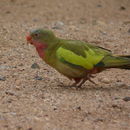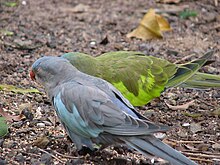en
names in breadcrumbs


Princess parrots communicate with a "Clack-clack" followed by a clucking sound, which sounds similar to domestic hens. Their call note is a simple whistle, however, they are quiet and rarely call.
Communication Channels: acoustic
Perception Channels: visual ; tactile ; acoustic ; chemical
These birds are rarely seen, and are labeled as a lower risk/near threatened species by the IUCN and as Appendix II by CITES. They are protected by law from capture. Threats to these birds include: habitat modifications, changes in the amounts of water available, changes in burning regimes, introduced predators and introduced competitors. BirdLife International estimates the population size to be 5,000 individuals.
CITES: appendix ii
IUCN Red List of Threatened Species: near threatened
The female Princess Parrot will lay on an average of four to six eggs. The incubation period for the eggs are approximately three weeks, where only the female sits on the eggs. Once the eggs hatch, the amount of time it takes until the young leave the nest, or fledging time, is about two to three months. The young will leave the nest and accompany their parents; it is very common for them not return to that breeding area for many years.
(Hiddert, 2001; Arndt Verlag, 2000; Wildlife Fact File, 1993; Barrett, 1949)
There are no known adverse affects of princess parrots on humans.
Australian Aborigines have been known to occasionally eat princess parrots and their young. Princess parrots can also be found in aviaries.
Positive Impacts: pet trade ; food
Because of their feeding habits, princess parrots have an impact on the plants and seeds they eat.
Princess parrots are herbivorous. Their diet is mainly herbaceous plants low to the ground, and grass seeds. Fruit and blossoms of the acacia are their preferred food. They also eat berries and other seeds.
Plant Foods: seeds, grains, and nuts; fruit; flowers
Primary Diet: herbivore (Folivore , Frugivore , Granivore )
Polytelis alexandrae (princess parrot), is found only in central and western Australia.
Biogeographic Regions: australian (Native )
Princess parrots are nomadic; they usually search out acacia trees, their favorite food source, which are found about twenty miles from water. They live in some of the largest deserts in the world, such as the Great Sandy Desert, the Gibson Desert and the Great Victoria Desert. These areas are open, sandy and dry with spinifex, casuarinas and acacia trees, eucalyptus scrubland, and grassland savannah.
Habitat Regions: tropical ; terrestrial
Terrestrial Biomes: desert or dune ; savanna or grassland ; scrub forest
There are no documented reports of the lifespan of princess parrots, however, other members of this family (Psittacidae) have been reported to live 20 to 30 years in captivity.
Average lifespan
Status: captivity: 23.9 years.
Princess parrots are sexually dimorphic by color. The male has a blue crown with blue-gray on the sides of head, and pink around the chin and throat. His body is olive-green, and the tops of his wings are bright green with a blue-violet under wing. He has orange eyes and an orange beak. His legs are gray with pink, and each foot has three black tipped toes. The female looks like the male, except her crown is a gray-mauve, her wings are a duller color green, and her tail feathers are shorter than the male's. The male has a wingspan of 161.5 mm on average, and the female has an average wingspan of 155.2 mm. Young are a duller color than their mothers until they are eight to nine months old. At this point the color differences between the males and females start to appear.
Princess parrots weigh 113.4 g, on average, and are about 45.72 cm in length.
Average mass: 113.4 g.
Average length: 45.72 cm.
Range wingspan: 155.2 to 161.5 mm.
Sexual Dimorphism: male larger; sexes colored or patterned differently; male more colorful
Other Physical Features: endothermic ; bilateral symmetry
There are very few reports of animals that prey upon princess parrots. This may be due to their rarity; they are not frequently seen by humans, and may also be infrequently seen by predators.
During courtship the male is very aggressive when approaching the female. The male will be in an upright position with raised head feathers, and his pupils will dilate and contract while he bobs his head. He will spread his wings and tail as he runs back and forth in front of the female.
We do not have information on mating systems for this species, however, since most parrots (family Psittacidae) are monogamous, it is likely that this species is too.
The breeding season is from September to December. The nests are usually found in holes at the top of high trees, or in holes of eucalyptus tree branches. There is often more than one nesting pair per tree. Nests are composed of fine sawdust/ wood shavings and are lined with small pieces of rotted wood. Females lay four to six eggs, on average. Eggs hatch in approximately 3 weeks and the chicks fledge after about 2 to 3 weeks. Princess parrots reach sexual maturity at the age of three to five years old, although some start breeding at a younger age. The earliest documented age at first reproduction is seven months. There are subtle physical traits that indicate sexual maturity, these include: blue feathers that appear on the front of the crown and on the rump of males; females acquire pinkish-mauve feathers on the crown and gray feathers on the rump.
Breeding season: September to December
Average eggs per season: 5.
Average time to hatching: 3 weeks.
Average fledging age: 2-3 weeks.
Average age at sexual or reproductive maturity (female): 3-5 years.
Average age at sexual or reproductive maturity (male): 3-5 years.
Key Reproductive Features: iteroparous ; seasonal breeding ; gonochoric/gonochoristic/dioecious (sexes separate); sexual ; oviparous
The incubation period for the eggs is approximately three weeks. Young are altricial. Once the eggs hatch, it takes about two to three weeks for the chicks to fledge. Once the young leave the nest neither they nor their mother will return to that particular area for many years.
Most parrots (family Psittacidae) have both male and female parental care; usually both parents take part in incubation and feeding young. This is likely to be true for this species as well.
Parental Investment: no parental involvement; altricial ; pre-fertilization; pre-hatching/birth (Protecting); pre-weaning/fledging (Provisioning); pre-independence (Provisioning)
The colourful princess parrot (Polytelis alexandrae) is an Australian bird of the parrot family. Its name was given in honour of Princess Alexandra of Denmark, who in 1863 married the Prince of Wales Edward VII and eventually became Queen of the United Kingdom. Other names for the species include: Queen Alexandra parrot (or parakeet), Alexandra's parakeet, Princess of Wales parakeet, rose-throated parakeet, and spinifex parrot. Their plumage is mostly green with a pink throat, bluish crown and rump, and bright green shoulders.

The princess parrot is a medium-sized parrot, 34 to 46 cm long and weighing between 110 and 120 g. The plumage is mostly green with a pink throat, bluish crown, and bright green shoulders. The rump is blue and the tail is long and narrow. The males have longer tail feathers and brighter coloring than females. The male also has a coral-red beak, while the female's is duller and has a greyish crown. Another difference is that the male has an orange iris, while the female's is much browner. In addition, the male of the species has a longer, projecting extension from the end of the 3rd primary (flight) feather on each side. This projection is called a 'spatula' or 'spatule' and appears in mature male birds.
This species is nomadic, arriving in small groups to breed and then disappearing. It is one of Australia's least known parrots because it is so elusive, even though it is spread across the interior of Australia. It inhabits arid woodland and scrub with spinifex, eucalypts, acacias, etc. They are unusual among parrots in engaging in mobbing behaviour against predators. They feed on the seeds of grasses and shrubs.
Four to six white eggs are laid which are incubated for 19 days. The chicks leave the nest about 35 days after hatching. These parakeets are truly opportunistic breeders, with pairs choosing to nest when food is plentiful.[2] They nest in a hollow in a eucalypt or desert oak.

The princess parrot can make loud calls.[2] Their life span is thought to be as long as 30 years. Under the right circumstances they are able to bond to more than one member of the host family. These birds have a short range of mimicking ability, yet some have the ability to "talk".[3] They are a favourite among many aviculturists and pet owners because of their looks and personality. Their diet consists of reasonable sized seeds and grasses that have seeds. They can be constipated if given bread or seeds that are small or become wet, they can become ill if seed bowls are contaminated by rats or mice so are best fed on an inverted ceramic pot with the bowl on top not wider than the top as they will dislodge the feed bowl.
There are three common color mutations of this parakeet. These colours are Lutino, Blue, and Albino (combination of Blue and Lutino). The natural, or 'normal' color is green. There are two types of blue, one blue winged and the second is bright blue wings and bright blue head.
The colourful princess parrot (Polytelis alexandrae) is an Australian bird of the parrot family. Its name was given in honour of Princess Alexandra of Denmark, who in 1863 married the Prince of Wales Edward VII and eventually became Queen of the United Kingdom. Other names for the species include: Queen Alexandra parrot (or parakeet), Alexandra's parakeet, Princess of Wales parakeet, rose-throated parakeet, and spinifex parrot. Their plumage is mostly green with a pink throat, bluish crown and rump, and bright green shoulders.